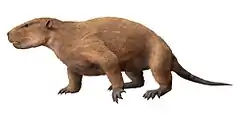Lambdopsalidae
Lambdopsalidae is a family of extinct multituberculate mammals from the Late Paleocene of Asia. They are part of Taeniolabidoidea, a clade otherwise present in the Early Paleocene (and possibly the Late Cretaceous) of North America; lambdopsalids, therefore, probably evolved from a single radiation that spread into Asia from North America in the mid-Paleocene or earlier. They are represented by the genus Lambdopsalis, Sphenopsalis and Prionessus.[1][2]
| Taeniolabidoidea | |
|---|---|
| Scientific classification | |
| Kingdom: | Animalia |
| Phylum: | Chordata |
| Class: | Mammalia |
| Order: | †Multituberculata |
| Superfamily: | †Taeniolabidoidea |
| Family: | †Lambdopsalidae |
| Genera | |
Though they haven't become as large as Taeniolabis, lambdopsalids were still large by multituberculate standards, the largest species weighting around 30 kg. They are notable for their unique dental speciations such as hypsodonty, which seem to imply speciations towards grazing.[1] Lambdopsalis is notable for offering direct evidence of hair and enamel and tooth prism patterns among multituberculates.[3]
Lambdopsalids lived in the final stages of the Paleocene, disappearing around the PETM. They co-existed with a variety of rodent species - in fact, rodents are thought to have first evolved and diversified in Asia -, indicating that there wasn't competition between both groups, having-coexisted together for several million years.[4]
References
- Williamson, Thomas E.; Brusatte, Stephen L.; Secord, Ross; Shelley, Sarah (2015). "A new taeniolabidoid multituberculate (Mammalia) from the middle Puercan of the Nacimiento Formation, New Mexico, and a revision of taeniolabidoid systematics and phylogeny". Zoological Journal of the Linnean Society. 177: 183–208. doi:10.1111/zoj.12336.
- New specimens of the multituberculate mammalian Sphenopsalis from the Paleocene of Inner Mongolia, China: implications for phylogeny and biology of taeniolabidoid multituberculates Article in Acta Palaeontologica Polonica 61(2) · January 2015 DOI: 10.4202/app.00117.2014
- Mao, Fangyuan; Wang, Yuanqing; Meng, Jin (2015). "A Systematic Study on Tooth Enamel Microstructures of Lambdopsalis bulla (Multituberculate, Mammalia) - Implications for Multituberculate Biology and Phylogeny". PLOS ONE. 10 (5): e0128243. doi:10.1371/journal.pone.0128243. PMC 4447277. PMID 26020958.
- Wood, D. Joseph (2010). The Extinction of the Multituberculates Outside North America: a Global Approach to Testing the Competition Model (M.S.). The Ohio State University.

